About the Report
What’s stealing executive time in 2025? Where are productivity gains actually happening—and what’s just hype?
To find out, we surveyed 508 business leaders, founders, and high-performing executives across industries. These are people who don’t just think about productivity—they’re responsible for it. For their teams, their companies, and themselves.
Now in its fourth year, the Executive Productivity Report is a snapshot of what’s really happening in people’s offices, in their meetings and 1to1s, behind their computer screens and browser tabs. It reveals what’s helping leaders hit their stride—and what continues to hold them back.
A note: data gathering for this report was slated to be done in late 2024. The combination of fast-moving AI development, Tariff talk, and economic uncertainty put us in a holding pattern. We wanted to make sure we were asking the right questions. So, we moved our survey to Spring 2025, giving us a short data-gap, but (we think) much more interesting insights!
The Evolution of Productivity in 2025
When we compared data from our 2025 survey to previous years, these productivity insights stood out:
- AI usage jumped 27 points—trust didn’t follow. In 2023, 51% of executives said they were using AI. In 2025, it’s 78%. But only 26% fully trust these tools, revealing a widening gap between adoption and confidence.
- Busywork is still the enemy—but fewer feel defeated. Administrative tasks remain a top productivity blocker (same as in 2023), yet only 4% of leaders in 2025 say their productivity has declined—down from 12% last year. That suggests leaders are learning to work around, if not eliminate, the drag.
- Productivity systems made a comeback. In 2023, just 35% of executives reported using a formal productivity system—a sharp drop from 67% in 2022. This year, that number rebounded to 64%, signaling a renewed appetite for structure and consistency.
- AI is shaping buying decisions. A majority of executives (60.6%) say they’re more likely to choose tools with advertised AI functionality—a clear increase from previous years, where interest was rising but not yet a decisive factor.
- Talent—not tech—is the new bottleneck. Despite all the focus on tools and automation, leaders say their biggest challenge in 2025 is finding skilled people. As in 2024, many are turning to non-traditional support—assistants, freelancers, and outsourced teams—to fill the gap.
A Word From Our Founder
In 2025, executive productivity is no longer tied to where work happens, it’s driven by the strategic combination of technology and intelligent staffing. The 2025 Prialto Executive Productivity Report—based on an in-depth survey of hundreds of senior leaders—shows how this powerful pairing is reshaping the way leaders maximize their time and impact.
One persistent challenge? Administrative overload. This year, a shift has emerged: executives are leaning heavily on artificial intelligence and human support to automate, delegate, and streamline operations.
The message is clear: in 2025, flexibility, intelligent delegation, and AI-powered workflows define executive success. The key issues are time and trust. They are too busy moving forward to make the time-input/time-reward tradeoff to invest in creating their own workflows. They want to rely on their support staff to maximize AI efficiency. Executives trust AI for speed and input accuracy, but not for wisdom or truthfulness. For this, they remain reliant on trusted support staff, empowered by AI for maximum output and value.
This year’s report dives deep into these trends and provides actionable insights to help leaders cut through distractions and maximize impact in a fast-changing business landscape.
- Eric Taussig, Founder and CEO of Prialto
Top Level Productivity Insights
Productivity isn’t just a metric—it’s a moving target. In this section, we zoom out to see how executive productivity has shifted year-over-year: what’s improved, what’s stalled, and where leaders are placing their bets for a more focused, high-impact 2025. From AI adoption to time-wasting tasks, this is the big-picture view of how work gets done at the top.
Looking Forward: What Impacts Productivity?

If you want to get more done this year, focus on technology and process. That’s what executives told us when we asked what they believe will have the biggest impact on their individual productivity in 2025.
With AI tools reaching new levels of sophistication, and more companies investing in automation, process improvement, and digital transformation, leaders are placing their bets on systems, not just smarts.
What do you think will have the biggest impact on your productivity this year?

33.86% of respondents identified technology as having the biggest impact on their productivity, closely followed by process improvements at 21.06%. This is the start of a notable trend—now, more than ever, executives are relying on technology and process to drive their productivity.
Is Work Location Really Changing for Executives?
Short answer: not much.
Despite the ongoing debate around return-to-office policies, our data shows that the workplace landscape for executives has largely stabilized post-COVID.
Where do you work?
.png?width=700&height=400&name=Chart%20-%20Work%20Location%20(2).png)
We're seeing a return to trend. Remote executive roles reached their peak in 2023 and have since stabilized. In 2025, only 14% of surveyed leaders report working fully remotely, down from 21% in 2023.
Meanwhile, the office holds steady: 48% of executives now work fully onsite.
This data suggests that, for executives, remote work is less of a revolutionary shift and more of a managed experiment that’s run its course. Most leaders are back in the office—or never left in the first place.
Who Do Executives Rely on For Productivity?
Let’s make one thing clear: Executives may be investing in tech, but people still power their productivity.
Who do you rely on most to help you be productive?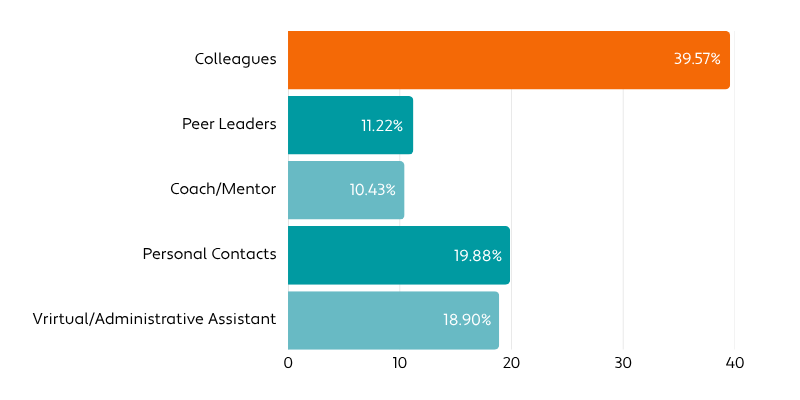
Even the most automation-savvy leaders still lean on staff to get work done. That’s especially true for founders and owners, who told us they’re more likely to rely on personal contacts to maintain productivity. Why? Fewer formal resources. More direct connection to the work.

What is the Busywork Impact on Productivity?

The relationship between administrative burden and executive productivity remains one of our most glaring findings.
Our dual analysis reveals:
- Over 50% of executives spend 30% or more of their day on busywork
- Most executives are productive for only 60-70% of any given workday
- Executives are spending about 8-12 hours per week on non-specialized work that takes time away from doing the work they are uniquely capable of doing
Despite spending nearly one-third of their time on administrative tasks, executives often resist delegation of busywork, which is eating away at peak productivity.
Productivity Trends
How did your productivity in the last 12 months compare to the year before?

Despite spending 20–30% of their time on administrative tasks, 2025 represents the strongest overall productivity confidence in our three-years of data, with 68% of executives reporting improved productivity and only 4% reporting a decline — the lowest negative rating we've recorded.
Executives are getting better at managing distractions—but busywork is still their biggest blocker. In fact, for the third year in a row, stress and admin work top the list of what’s getting in the way.
Productivity blocker breakdown:
- Stress and overwhelm – 30.91%
- Too many meetings – 23.43%
- Administrative tasks – 29.72%
- Procrastination – 13.98%
The persistence of administrative work as a top-3 blocker, with executives spending 20-30% of their time on such tasks, underscores the urgent need for better delegation and automation strategies.
People Challenges
If you ask executives what’s slowing progress, they won’t point to AI adoption. They’ll point to people.
Not because people are the problem—but because finding the right ones is.
Whether they’re building teams from scratch or trying to scale what’s already working, executives continue to cite hiring and retaining talent as their biggest obstacle to productivity. And in 2025, it’s not just about headcount. It’s about fit, skill, and speed.
Building a Productive Workforce
What are your biggest hiring challenges?

When we examine the primary challenges executives face in building productive teams, talent acquisition emerges as the overwhelming concern. While cost management, prioritization, and budgeting all present significant hurdles, business leaders consistently identify finding skilled talent as their greatest obstacle.
The Skills Gap Reality:

Non-Traditional Hiring Solutions:
Faced with traditional talent shortages, executives are increasingly turning to alternative staffing models, hiring:
- Contractors
- Freelancers
- Outsourced specialists
- Virtual team

These models aren’t just about saving money. They’re about plugging skill gaps quickly and avoiding the lag time of traditional recruiting.
Productivity isn’t a hiring goal anymore—it’s a hiring requirement. If someone can’t hit the ground running, they’re a liability, not an asset.
The relationship between talent challenges and alternative hiring solutions demonstrates executive adaptability. As traditional recruitment becomes more difficult, leaders are becoming more creative and flexible in their approach to team building.
Working with an Assistant
Administrative support continues to play a crucial role in executive productivity, with 72.24% of business leaders relying on administrative or executive assistants to help manage their workload and reduce the impact of routine tasks.

For all the AI hype, one of the most underrated productivity investments remains what it’s always been: a good assistant. But here’s the twist—87.19% of those assistants are in the office.
That’s right: Despite the availability of remote and offshore talent, executives are still leaning heavily on local support. Only 1.36% of surveyed leaders reported having a remote or outsourced EA.
For founders and owners, the situation looks even leaner. They’re much less likely to have formal assistant support—and more likely to lean on personal contacts for help. It’s a scrappier approach that reflects the unique constraints of running a leaner operation.
Among executives who utilize assistants, the sharing model dominates:
- 83.92% share their assistants with other executives or departments
- 16.08% have dedicated, exclusive assistant relationships
This shared resource approach optimizes cost, giventhe part-time nature of many administrative needs even while the personal nature and inability to completely routinize these tasks prevents firms from delegating them to back-office shared service centers.
Scope of Executive Assistant Work
What does your assistant do for you?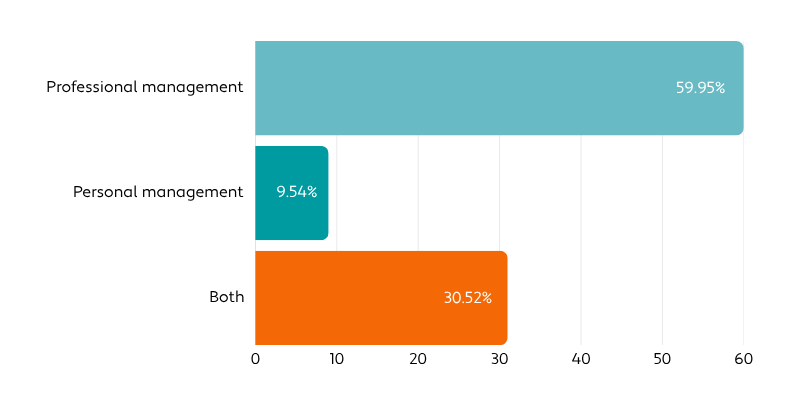
Do you use your assistant for: 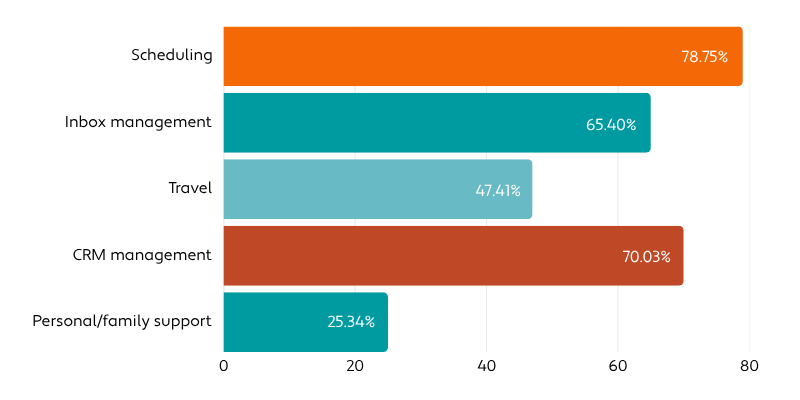
Executive assistants remain focused primarily on core administrative functions.
The limited expansion into personal task management suggests an opportunity for executives to gain additional productivity benefits by broadening the scope of assistant support. Companies might consider how they can encourage more personal delegation, understanding that personal productivity also unleashes more productive energy at work.
How Long Are Executives Working with Assistants?
.png?width=800&height=400&name=Chart%20-%20Assistant%20Longevity%20(1).png)
As for tenure, most executives reported working with their assistants for 1–3 years, followed by 3–5 years, suggesting that while the nature of work may be changing, the value of long-term, trusted support hasn’t gone anywhere.
Leaders who have reliable assistants are keeping them. And those without one? They’re spending more time fighting fires alone.
Executive Assistant Acquisition


In 2025, the top source for executive assistant talent is the internet, in fact:
- 21.63% of leaders are finding their assistants online
- 28.07% are finding them through personal references
- 20.71% are using a recruiter
- 17.17% find their assistants through an agency or virtual assistant company
This mix of methods reveals two things:
- Executives are open to remote, digital-first hiring—especially for roles like assistants that don’t require physical proximity.
- Trust still matters. Even in a world of endless digital options, a recommendation from someone you trust is still one of the most powerful hiring channels.
Executive Assistant Tools
What software tools does your assistant use?

The best assistants aren’t just calendar wranglers—they’re power users of productivity tech.
When we asked executives what tools their assistants use regularly, the results told a clear story: modern assistants are deeply embedded across core business functions.
Here’s the breakdown:
- 64% use project management software, CRM platforms, and email/calendar clients—the essential command centers of executive work.
- 56% work within HR tools, helping manage onboarding, benefits, and internal coordination.
- 47% handle bookkeeping software, keeping tabs on expenses, invoices, and financial tracking.
- 43% manage travel logistics using dedicated booking and itinerary platforms.
- 39% support marketing operations, using tools to schedule content, manage campaigns, and track performance.
Today’s assistants aren’t on the sidelines—they’re in your dashboards.
They’re inside the same tools as their executives, not just supporting workflows but actively running them. And as their tech fluency grows, so does their impact—turning administrative support into operational horsepower.
Process Challenges
Technology might be flashy. Talent might be foundational. But if your processes are broken? Productivity doesn’t stand a chance.
Executives in 2025 are learning this the hard way: even with great tools and great people, they’re still wasting time if their workflows aren’t dialed in.
And yet—many leaders are still navigating these challenges without a structured system in place.
Productivity Systems
Do you adhere to a productivity system?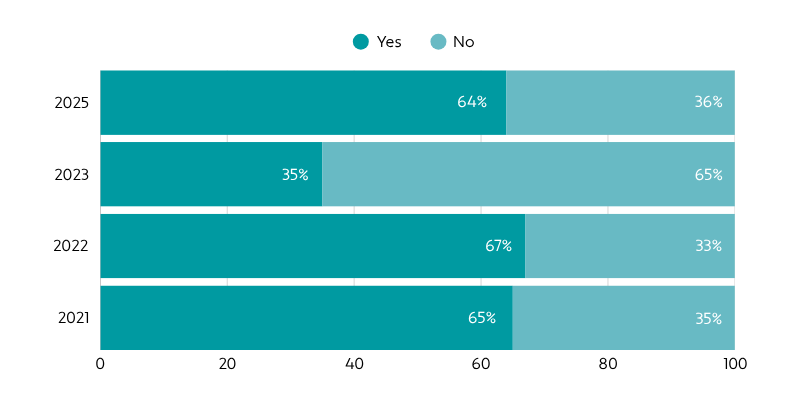
After a sharp and surprising drop in 2023, productivity systems are back in use among executives—64% report using productivity systems in 2025, putting adoption levels nearly back to pre-drop norms.
So what happened in 2023?
It may have been an anomaly or a temporary backlash. A combination of tool fatigue, post-pandemic burnout, and a hunger for simplicity likely led some leaders to abandon rigid systems in favor of more intuitive workflows.
But this year’s rebound suggests that structure still wins—especially when leaders are under pressure to deliver more with less.

Which productivity Systems do you use?.png?width=800&height=400&name=Chart%20-%20Productivity%20Systems%20(1).png)
When we asked executives which productivity systems they rely on, one thing stood out: there’s no clear winner.
Most leaders cobble together a digital toolkit that works for their needs. Think:
- Calendars and time-blocking
- Task management tools (like Asana, ClickUp, or Trello)
- Project tracking platforms
- Custom Notion dashboards
- Personal to-do apps
And yet, the most common theme wasn’t the tools themselves—it was executive adaptability. Executives want systems that mold to their work, not the other way around.
The diversity in system preferences suggests that productivity effectiveness depends more on consistent application than on specific methodological choices.
Personal Systems
It’s not just workflows—many executives extend their systems mindset into their daily routines. From eating to exercise habits, productivity isn’t confined to the work calendar. 42.72% of executives follow a special diet, and 46.65% of executives regularly visit a gym.
For many leaders, health is a system, and optimizing it is just another lever for peak performance.
Technology Challenges
We’ve never had more tools to boost productivity—and yet, productivity still feels hard.
That’s because technology, while powerful, comes with its own friction. Too many platforms. Too much context switching. And not enough clarity on what’s actually making a difference.
So we asked executives how they’re navigating their tech stacks in 2025. The answer: strategic caution.

The majority of business leaders (61%) operate within a 3-5 tool ecosystem for daily work management. This represents the sweet spot between functionality and cognitive overhead - enough tools to handle diverse needs without creating excessive context switching between chat, email, CRM, and task management.
Do you seek out new productivity tools and apps?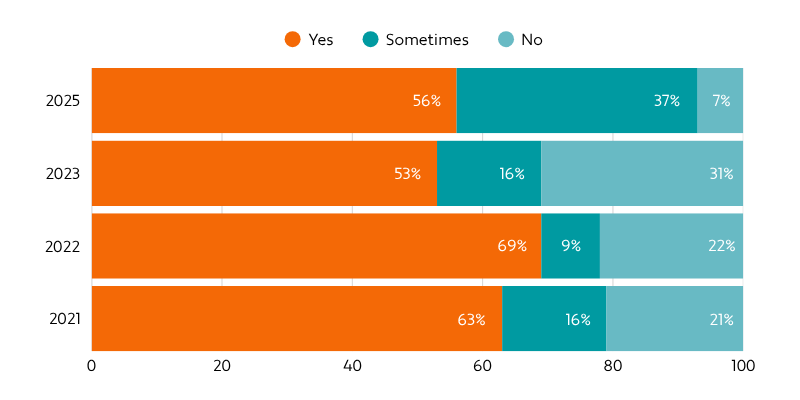
In 2025, more leaders than ever are in the “maybe” camp—with 37% saying they’re sometimes seeking new tools. That’s a major shift from previous years, where responses were more binary.
Executives aren’t swiping right on every shiny new app. They’re exploring tech more thoughtfully, choosing tools that truly align with their goals—and ignoring the rest.
What productivity tools are executives using to stay productive?
|
|
Task Management |
CRM |
Scheduling Software |
Time Management |
AI Tools |
|
2025 |
68% | 51% | 52% | 45% |
51% |
|
2023 |
65% | 37% | 51% | 50% |
- |
The productivity stack is still dominated by the classics: task management, CRM, scheduling, and time management apps. But what’s new this year is that a staggering 51% of executives and their assistants are using AI tools, indicating rapid integration of artificial intelligence into executive workflows.
Still, the core stack hasn’t changed much: executives are juggling calendars, managing clients, organizing tasks, and trying to track their time. The real challenge isn’t the tools themselves—it’s the context switching between them.
Technology's Impact on Productivity
Do you feel like the software you use makes your life easier?

A majority of executives (72.44%) say that the software they use makes their lives easier. Remember that we asked leaders which area had the biggest impact on their productivity, and a full 33.86% pointed to the technology they use—beating out people and process in some segments.
This reinforces what we’re seeing across the board: leaders are betting big on tech—but they’re also more skeptical than ever.
The lesson? It’s not about having more tools—it’s about having the right ones, integrated in the right way.
The AI Impact on Productivity
Have you incorporated any AI tools into your workday to enhance your productivity?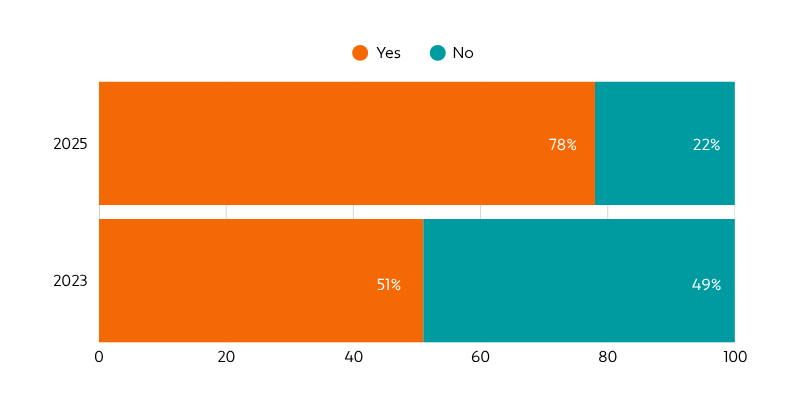
It’s official: AI has gone mainstream.
In 2023, just over half of executives said they were using AI in their day-to-day work. Fast forward to 2025, and 78% report that AI tools are now part of their daily workflow.
That’s a massive leap in just two years—and it confirms what many suspected: AI isn’t a passing trend. It’s becoming tablestakes for executive productivity.

Despite widespread AI adoption, organizational policies haven't kept pace with usage. 38% of executives haven’t yet defined clear internal guidelines on what’s acceptable AI use. This creates potential risks around data security, compliance, and consistent application across teams.
Which AI tools do you use the most often?

While ChatGPT maintains its position as the dominant AI tool used by executives, 2025 shows much greater diversity in AI tool adoption compared to 2023's 88% ChatGPT dominance. Executives now use:
- ChatGPT (primary tool for majority)
- Gemini
- Perplexity
- Grammarly
- Other AI tools
When asked if they’re more likely to choose a productivity tool that advertises AI functionality, 60.63% of executives said yes, and another 27.36% said sometimes. Only 12% said AI features don’t influence their decision.
AI has become a must-have marketing feature—but that doesn’t mean blind adoption. Executives are drawn to AI-powered tools, but in a market flooded with AI promises, only the tools that prove real value will earn long-term trust.
The AI Trust Gap
How much do you trust the AI tools you use?

While 78.35% of business leaders use AI, only 26.38% say they fully trust it.
That’s the tension we see playing out across industries: high usage, middling trust.
Executives are leveraging AI to automate scheduling, generate reports, write content, draft emails, and conduct research—but they’re still reviewing the output carefully. They’re wary of hallucinations, inaccuracies, and ethical blind spots.
It’s not that they think AI can’t help. It’s that they know AI can’t replace judgment.
AI isn’t a magic wand—it’s a power tool. And like any power tool, it’s only effective in the hands of someone who knows what they’re doing.
Do you feel like the AI tools you use make your life easier?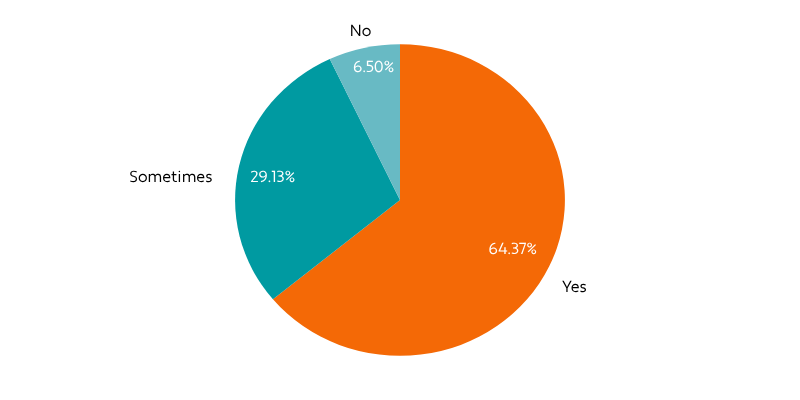
Despite the trust gap, most executives say AI is making a positive difference: 64.37% say AI has had a positive impact on their productivity.
This suggests executives are finding practical value in AI while maintaining appropriate caution about its limitations. The integration phase continues, with leaders using AI for efficiency while retaining human oversight for critical decisions.
Conclusion
If the last few years around the COVID-19 pandemic felt like they were about survival and adaptation, 2025 is about intentional evolution.
Executives aren’t just trying to do more—they’re focused on doing what matters most. They’re building systems that flex with them. They’re outsourcing more. They’re adopting AI, but not surrendering to it. And critically, they’re getting better at protecting their time from the low-value tasks that once defined their day.
Let’s recap what’s driving productivity forward—and what’s still dragging it down:
What’s working:
- A renewed embrace of structured systems and streamlined workflows
- Increased use of AI for automating low-leverage tasks
- Reliance on high-impact people: assistants, contractors, and non-traditional talent
- Healthier personal systems that blend productivity with wellbeing
What’s still a challenge:
- Busywork continues to chew up 20–30% of leaders’ time
- Trust in AI tools lags behind usage
- Founders and small business owners lack the support systems their larger counterparts rely on
- The right talent remains hard to find—and harder to retain
- Leaders are running leaner teams, making bigger bets on automation, and juggling more responsibilities than ever. The ones succeeding are those who treat productivity as a strategy, not a set of hacks. They're asking not just how to get more done, but why—and what they can eliminate to make space for high-return, high-focus work.
As 2025 unfolds, the most productive executives won’t be the busiest. They’ll be the boldest: willing to offload, automate, and rethink the way they lead.
Demographics




